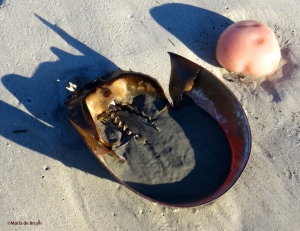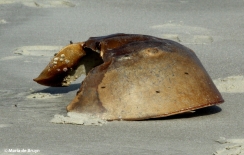 On a trip to Huntington Beach State Park in South Carolina, we took a few walks along the Atlantic shoreline. There I saw the remains of numerous horseshoe crabs (Limulus polyphemus) as their empty shells were scattered among sea pork and sea weed on the beach.
On a trip to Huntington Beach State Park in South Carolina, we took a few walks along the Atlantic shoreline. There I saw the remains of numerous horseshoe crabs (Limulus polyphemus) as their empty shells were scattered among sea pork and sea weed on the beach.
Horseshoe crabs, which can become quite large, live in shallow ocean waters on soft sandy or muddy bottoms. They occasionally come on shore to mate. Behind their five sets of legs (the remains of which are seen in the photos below), they have book gills, which exchange respiratory gases. Two gills are seen sticking up in the center of the first photo.
The gills are also occasionally used by the crabs to swim, which they usually do upside down.
 When I posted photos of my crab shell spottings on Project Noah, a fellow Noah member informed me that the horseshoe crabs are used in medicine. So I decided to read up on them and discovered how they are utilized. These crabs have hemocyanin instead of hemoglobin in their blood to carry oxygen (this colors their blood blue). Their blood also contains amebocytes, which defend these creatures against pathogens. The blood of the horseshoe crabs is harvested to obtain the amebocytes to make a product that used to detect bacterial endotoxins in human medical applications.
When I posted photos of my crab shell spottings on Project Noah, a fellow Noah member informed me that the horseshoe crabs are used in medicine. So I decided to read up on them and discovered how they are utilized. These crabs have hemocyanin instead of hemoglobin in their blood to carry oxygen (this colors their blood blue). Their blood also contains amebocytes, which defend these creatures against pathogens. The blood of the horseshoe crabs is harvested to obtain the amebocytes to make a product that used to detect bacterial endotoxins in human medical applications.
The US Food and Drug Administration mandates that any intravenous drugs and forms of medical equipment that come into contact with patients’ bodies must pass through horseshoe crab blood to help rule out contamination with endotoxins. This includes items such as needles, surgical implants and pacemakers.
 To obtain the supplies, about 600,000 crabs are caught each year and drained of about 30% of their blood before being returned to the ocean. Some 10-30% of the crabs do not survive the procedure and others are injured, becoming unable to mate and reproduce. As a consequence of the harvests, these magnificent arthropods, whose lineage dates back 450 million years ago, are now becoming threatened and alternative toxin-detection methods are needed. There is a website devoted to these interesting crabs. Walks on the beach can lead to new knowledge as well as enjoyment!
To obtain the supplies, about 600,000 crabs are caught each year and drained of about 30% of their blood before being returned to the ocean. Some 10-30% of the crabs do not survive the procedure and others are injured, becoming unable to mate and reproduce. As a consequence of the harvests, these magnificent arthropods, whose lineage dates back 450 million years ago, are now becoming threatened and alternative toxin-detection methods are needed. There is a website devoted to these interesting crabs. Walks on the beach can lead to new knowledge as well as enjoyment!





Another interesting story!
LikeLike
Thanks, Malai!
LikeLike
Great posting on horseshoe crabs. I had no idea they were used in medicine. Thanks Maria!
>
LikeLike
It was a revelation to me, too, Mary! Makes you wonder in what ways animals are used in medicine otherwise. I know that drugs are tested on them and valves from pigs are used in heart surgery.
LikeLike